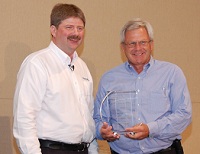 Nothing like moving across country to put you a bit behind. Just a couple of things left over from last month’s 10th International Conference on Precision Agriculture that I wanted to share with you. First and foremost is the awards handed out at the ICPA gathering. The awards were presented by Paul Schrimpf, Group Editor the CropLife Media Group at Meister Media Worldwide, which includes PrecisionAg.com, the award sponsors.
Nothing like moving across country to put you a bit behind. Just a couple of things left over from last month’s 10th International Conference on Precision Agriculture that I wanted to share with you. First and foremost is the awards handed out at the ICPA gathering. The awards were presented by Paul Schrimpf, Group Editor the CropLife Media Group at Meister Media Worldwide, which includes PrecisionAg.com, the award sponsors.
Paul presented the Farmer Award to Ken Dalenberg (above) of Marshfield, Illinois – who was recognized for the role he has played in helping to develop and promote new agricultural technology for crop management. Ken has worked with a number of research projects on his farm to evaluate precision farming technology, along with other innovative products and practices through the University of Illinois, the Potash & Phosphate Institute, the United Soybean Board, and others.
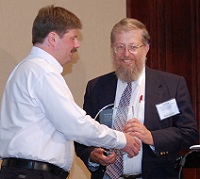 Dr. Jess Lowenberg-DeBoer of Purdue University (left) and Dr. Harold Reetz (right, below) of Reetz Agronomics were honored with Legacy Awards during the conference. Dr. Lowenberg-DeBoer’s work in precision agriculture economics included groundbreaking research into the profitability of every aspect of it, including tracking the adoption of technology at the farm and service provider level, which played an important role in the growth of precision.
Dr. Jess Lowenberg-DeBoer of Purdue University (left) and Dr. Harold Reetz (right, below) of Reetz Agronomics were honored with Legacy Awards during the conference. Dr. Lowenberg-DeBoer’s work in precision agriculture economics included groundbreaking research into the profitability of every aspect of it, including tracking the adoption of technology at the farm and service provider level, which played an important role in the growth of precision.
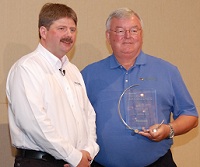 Reetz has been a champion of technology and precision agriculture throughout his four decade-long career, founding the InfoAg Conference in the mid-1990s as a way of getting people together to share experiences and build a networked community of vendors, users, and service providers. Now with Reetz Agronomics, Harold continues his champion role, especially in the use of precision technology for conservation. Chuck just did an interview with him last week at the Conservation in Action Tour.
Reetz has been a champion of technology and precision agriculture throughout his four decade-long career, founding the InfoAg Conference in the mid-1990s as a way of getting people together to share experiences and build a networked community of vendors, users, and service providers. Now with Reetz Agronomics, Harold continues his champion role, especially in the use of precision technology for conservation. Chuck just did an interview with him last week at the Conservation in Action Tour.
Picking up the Consultant/Entrepreneur Award was the OptiGro Team at Jimmy Sanders, Inc. of Cleveland, MS. In addition, there were several student winners recognized at the event, including: Eric Allphin, Xystus Amakor, David Harper, Ming Li, Joe David Luck, Daniel K. Mullenix, Georg Ruß, Ajay Sharda, Yeyin Shi and Luciano S. Shiratsuchi. There’s too many pictures to put them all in this one post, but you can see all the photos at the conference Flickr photo site below.
ICPA Photo Album
Coverage of the 10th International Conference on Precision Agriculture brought to you on Agwired by  When it has to be RIGHT!
When it has to be RIGHT!
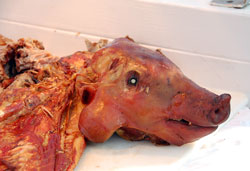 You can’t have a swine health seminar without having a little pig on the menu and at the Boehringer Ingelheim Vetmedica Swine Health Seminar we got it at our closing dinner which was a luau on the lawn. I have just updated the photo album with a lot of photos from yesterday’s events that include the dinner and entertainment. I think I’ll have a video clip to add to this post later too.
You can’t have a swine health seminar without having a little pig on the menu and at the Boehringer Ingelheim Vetmedica Swine Health Seminar we got it at our closing dinner which was a luau on the lawn. I have just updated the photo album with a lot of photos from yesterday’s events that include the dinner and entertainment. I think I’ll have a video clip to add to this post later too.
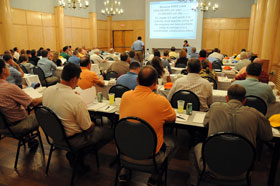 It’s always good to hear from the producers who attend a farm production meeting like the
It’s always good to hear from the producers who attend a farm production meeting like the 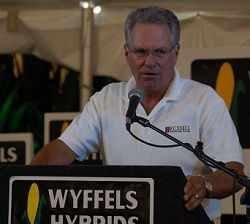
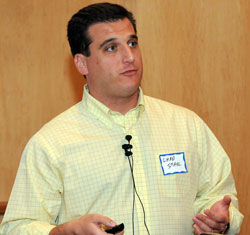 The last presentation at the
The last presentation at the 



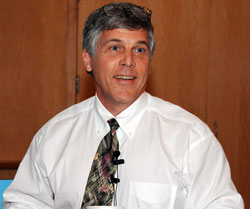 We’ve heard about the oral testing of hogs for disease from
We’ve heard about the oral testing of hogs for disease from 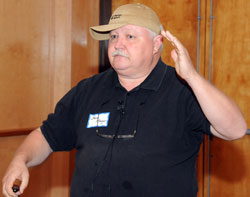 The participants at the
The participants at the 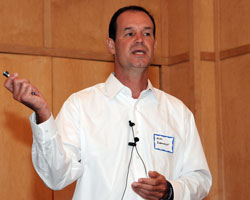 When it comes to hog production your veterinarian is one of the first sources of information and often considered a “team member.” At the Boehringer Ingelheim Vetmedica Swine Health Seminar Mike Elsenmenger, DVM,
When it comes to hog production your veterinarian is one of the first sources of information and often considered a “team member.” At the Boehringer Ingelheim Vetmedica Swine Health Seminar Mike Elsenmenger, DVM,  The first presentation of the Boehringer Ingelheim Vetmedica Swine Health Seminar focused on the control of Porcine Reproductive and Respiratory Syndrome which is better know as the PRRS virus. Dr. Laura Batista, DVM,
The first presentation of the Boehringer Ingelheim Vetmedica Swine Health Seminar focused on the control of Porcine Reproductive and Respiratory Syndrome which is better know as the PRRS virus. Dr. Laura Batista, DVM,  The emcee for the North Carolina Swine Health Seminar is David Gocken,
The emcee for the North Carolina Swine Health Seminar is David Gocken,